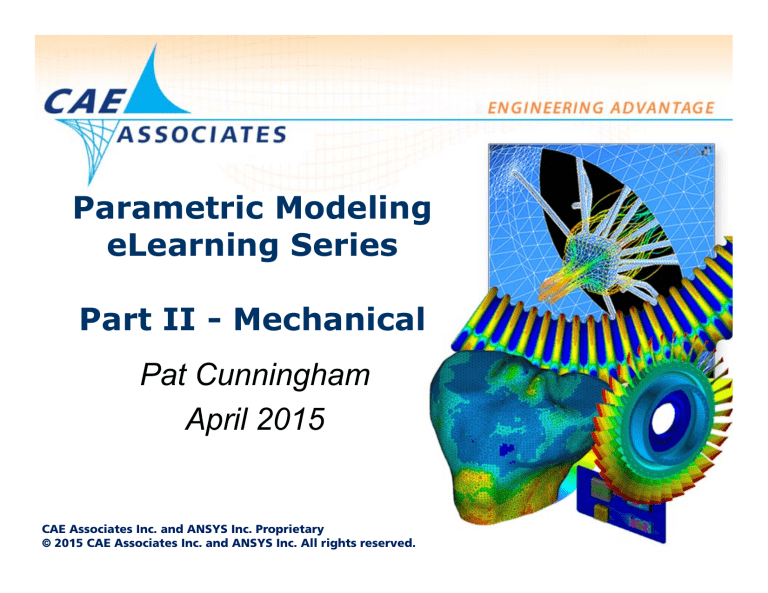
Parametric Modeling
eLearning
g Series
Part II - Mechanical
Pat Cunningham
A il 2015
April
CAE Associates Inc. and ANSYS Inc. Proprietary
© 2015 CAE Associates Inc. and ANSYS Inc. All rights reserved.
CAE Associates Inc.
Engineering Consulting Firm in Middlebury, CT specializing in FEA and
CFD analysis.
ANSYS® Channel Partner since 1985 providing sales of the ANSYS®
products, training and technical support.
2
e-Learning Webinar Series
This presentation is part of a series of e-Learning webinars offered by
CAE Associates.
You can view many of our previous e-Learning session either on our
website or on the CAE Associates YouTube channel:
If you are a New Jersey or New York resident you can earn continuing
education credit for attending the full webinar and completing a survey
which will be emailed to you after the presentation.
3
CAEA Resource Library
Our Resource Library contains over 250 items including:
—
—
—
—
Consulting Case Studies
Conference and Seminar Presentations
Software demonstrations
Useful macros and scripts
The content is searchable and you can download copies of the material to
review at your convenience
convenience.
4
CAEA ANSYS® Training
Classes can be held at our Training Center at CAE Associates or on-site
at your location.
CAE Associates is offering on-line training classes in 2015!
Registration is available
a ailable on o
ourr website.
ebsite
5
CAEA Engineering Advantage Blog
Our Engineering Advantage Blog offers weekly insights from our
experienced technical staff.
6
Parametric Modeling eLearning Series
Part I – Parametric Geometry
—
—
Part II – Parametric Finite Element Modeling
—
—
—
—
—
Feature based geometry: Pros and Cons
Direct geometry – Pros and Cons
Material coefficients
Mesh controls
C t t settings
Contact
tti
Loads
Results
P t III – Using
Part
U i aP
Parametric
ti M
Model
d l ffor O
Optimization
ti i ti
—
—
—
—
Manual approach
Automated design studies
Direct Method
Response surface method
7
Parametric Modeling with Finite Elements
Quick review: Parametric Modeling is an approach to analysis that
engineers and designers can use to get the most from their finite element
models.
—
—
—
—
A parametric modeling approach involves defining parameters to represent the
inputs to the system. Output parameters are defined to evaluate the response.
In Part I of this series we discussed several approaches to setting up geometry
input parameters using feature based and direct modeling tools.
The recording of Part I can be viewed on our website at www.caeai.com or on
our YouTube channel.
Search for “eLearning” in either location for a list of previously recorded
webinars.
8
Part II – Finite Element Model Parameters
The input quantities required to generated a finite element model are:
—
—
—
—
—
Material Properties (Elastic Modulus, Density, CTE, Conductivity, etc.).
Mesh settings to define the size and shape of the elements used.
Connections between parts in an assembly (joints or contact elements)
elements).
Loads (Forces, Pressures, Heat Flow, etc.).
Supports to react out the loads (most FEA solutions are based on equilibrium).
Output quantities are used to evaluate the response of the system.
—
—
The most common output parameter used in an optimization study is the
system mass.
mass
Any result quantity (deformation, force, strain, stress, etc.) can be tracked
using the Workbench Parameter Set.
9
Part II – Finite Element Input Parameters
Material Properties
—
Material coefficients are controlled parametrically by adding them to the
Project Parameter Set.
10
Part II – Finite Element Input Parameters
Parametric mesh controls can be used to:
—
—
Relate the element size controls to the geometry parameters.
Automate mesh refinement studies.
To make a mesh control parametric simply click on the box to the left the
value in the Details window to add it to the project Parameter Set.
11
Part II – Finite Element Input Parameters
Load magnitudes are added to the Project Parameter Set from the
Details menu.
12
Part II – Finite Element Input Parameters
In addition to the load magnitudes
magnitudes, the positioning (offsets) of remote
loads can also be controlled parametrically.
13
Part II – Finite Element Input Parameters
MAPDL macro arguments can be driven parametrically when the desired
setting is not available in the Details menu.
For example, contact normal stiffness (FKn) can be defined parametrically
by modifying the real table of the contact pair:
14
Part II – Finite Element Output Parameters
Output parameters are used to track the response of the system
system.
—
Mass is added to the project Parameter Set in the details of the Geometry.
15
Part II – Finite Element Output Parameters
The common result quantities (deformation,
(deformation strain,
strain stress,
stress etc.)
etc ) are tracked
by adding them to the project Parameter Set via the Details menu.
Note that min and max values for scoped regions can be tracked.
Renaming the result
res lt items helps you
o to keep track of the o
outputs
tp ts in the
Parameter Set.
16
Part II – Finite Element Output Parameters
Probe items are useful for tracking reaction forces and moments for
support boundary conditions.
Max and min quantities for path and surface interpolated results can also
be added to the Parameter Set
Set.
17
Part II – Finite Element Output Parameters
User Defined Results can be tracked in the same fashion as other results
results.
18
Part II – Finite Element Output Parameters
Scalar quantities from MAPDL macros can be filetered out and added to
the Parameter Set.
19
Example Problem
Lego man hip replacement design
design.
20
Part II – Parametric Finite Element Models
Example 1 – Load sensitivity
—
Parametrically control the location of the remote force to determine the
sensitivity of the deflection and stress response.
21
Part II – Parametric Finite Element Models
Example 2 – Automated mesh refinement study
—
Parametrically control the element size and compare it to the stress result in a
specified region of the model.
22

